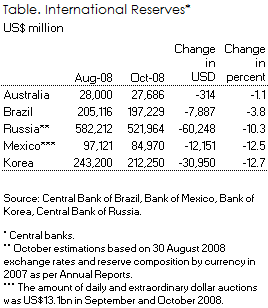Fear of intervening
16 November 2008
Ousmène Mandeng, Ashmore Investment Management
One of the most puzzling phenomena of the current financial crisis is the fact that despite the very large accumulation of international reserves mostly denominated in dollars, the international economy has suffered a severe shortage of dollar liquidity. The unexpected acute dollar shortage has led to significant downward pressure on many currencies. Such sudden dollar shortages can normally be accommodated by selling international reserves. Yet, central banks have seemingly not been able to fully mobilise their reserve assets.
Central banks have long been suspected of a “fear of floating”, namely even those central banks that have stated that they float their currencies actually do not.1 Following the Asian crisis and subsequent crises in Russia, Brazil and Turkey, consensus seemed to have emerged that countries need to choose between either adopting a hard peg or a freely floating exchange rate. Many floating exchange rates though have seen preciously little fluctuations suggesting that central banks have suppressed floating to promote export-led growth and build up foreign exchange reserves but also out of concern of fuelling instability. Yet, the past few weeks have seen significant exchange rate movements. The rapid depreciation at least in some cases has raised doubts about central banks’ willingness and capacity to intervene in the exchange market. Far from fearful to float, central banks seem fearful to intervene.
Most major exchange rates have depreciated against the U.S. dollar since August by as much as 20-30 percent. In April-July 2002, the last time the Brazilian real depreciated by 30 percent against the dollar in a relatively short period of time, it triggered general market turmoil and a massive augmentation of the then IMF arrangement. While in a pegged exchange rate regime, intervention is normally by rule, in a floating exchange rate regime, the decision to intervene is of course by discretion. A pure floater would not intervene unless to avoid a disorderly exchange rate adjustment. Some floaters have intervened but some have not. This may be due to central banks believing that the exchange rate depreciation are justified on fundamental grounds, desirable to reverse prior appreciation that risk eroding export competiveness, that there is a concern to give up precious foreign exchange reserves or that intervention is simply not effective. Given the sharp exchange rate movements, there seems to have been a case for intervention for peggers and floaters alike.
Scale of and approaches to interventions have differed during the recent episode. Where central banks intervened, in most instances interventions had fallen well short of arresting currencies’ slides. The Bank of Mexico has been the most transparent amid its rule-based foreign exchange intervention. The central bank of Russia intervened, probably spending the largest amount in nominal dollar terms although significant reserves have also been allocated for bank rescue operations. In contrast, the Reserve Bank of Australia does not seem to have intervened at all (Table).
The fear of intervening raises doubts about the effectiveness of holding reserves. Central banks seem to have missed an opportunity to test their intervention capacity. An immediate lesson from the crisis may therefore be that foreign exchange reserves are not sufficient a condition to avert a substantial attack on currencies. While the counter-factual is, as always, hard to prove, it seems surprising that large reserve holders have neither mobilised their reserves fully nor have the large reserve levels been sufficient a deterrent for market participants. The recent extension of swap lines by the U.S. Federal Reserve already suggests that conventional reserve holdings are not efficient. Regardless of the underlying reason that made central banks seemingly reluctant interveners, they will have to review in earnest their objectives and management of foreign reserves. Unless the market believes that the recent exchange rate movements were too insignificant, the fear of intervening may have greatly diluted the power and significance of holding reserves.
